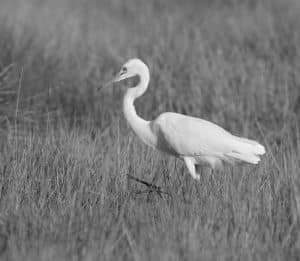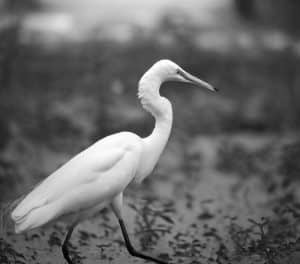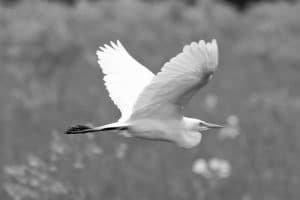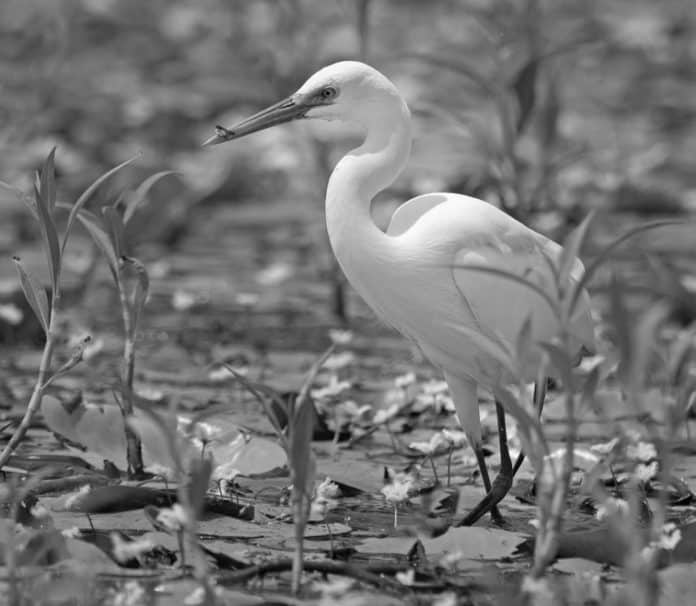Introduction to the Intermediate Egret
The intermediate egret in Tanzania, scientifically known as Ardea intermedia, is a medium-sized bird belonging to the heron family, Ardeidae. As the name suggests, it is considered to be intermediate in size between the larger great egret and the smaller little egret. With its slender, elegant build and striking white plumage, the intermediate egret is a sight to behold in the wetlands of Tanzania. During the breeding season, these birds develop long, delicate plumes on their backs, adding to their allure and beauty.
The intermediate egret is known for its distinctive feeding behavior, often seen wading through shallow waters in search of fish, frogs, and other aquatic prey. Their long legs and necks, coupled with a sharp, pointed beak, make them adept hunters in their watery habitat. These birds also play a crucial role in the ecosystem by regulating the populations of their prey species and contributing to the overall balance of wetland ecosystems.
In Tanzania, the intermediate egret can be found in a variety of wetland habitats, including rivers, lakes, marshes, and coastal lagoons. These diverse environments provide the ideal conditions for these birds to forage and breed, making Tanzania a vital stronghold for the species in East Africa.
Habitat and Distribution of the Intermediate Egret in Tanzania
The intermediate egret is widely distributed across the African continent, with a significant population found in Tanzania. The country’s extensive network of wetlands, including the famous Serengeti and Selous Game Reserves, provides essential habitats for these birds. The Rufiji River, in particular, is known to support a thriving population of intermediate egrets, offering abundant food sources and suitable nesting sites.
These birds are highly adaptable and can be found in both freshwater and saltwater wetlands, making them a common sight along the shores of Tanzania’s lakes and coastal areas. The presence of these elegant waders adds to the rich tapestry of wildlife that calls Tanzania home, contributing to the country’s allure as a prime destination for bird enthusiasts and nature lovers.

Despite their adaptability, the intermediate egret faces various threats to its habitat and survival in Tanzania, including habitat loss due to human encroachment, pollution of wetland ecosystems, and disturbances caused by human activities. Conservation efforts aimed at protecting and preserving these vital habitats are essential to ensuring the continued presence of the intermediate egret in Tanzania’s wetlands.
Physical Characteristics and Behavior of the Intermediate Egret
The intermediate egret is characterized by its slender, elegant build, standing at around 65-70 centimeters in height. Its striking white plumage, contrasting with jet-black legs and feet, makes it a visually stunning bird, especially during the breeding season when it develops long, wispy plumes on its back. These plumes, known as aigrettes, are a distinctive feature of the species and have unfortunately made them targets for illegal wildlife trade in the past.
In addition to their physical beauty, intermediate egrets are known for their graceful and deliberate movements as they wade through shallow waters in search of prey. Their long, slender necks allow them to strike with precision, swiftly capturing fish and other aquatic creatures with their sharp, pointed beaks. Observing these birds in their natural habitat is a testament to the elegance and efficiency of their feeding behavior, offering a captivating spectacle for birdwatchers and wildlife enthusiasts.
When not actively foraging, intermediate egrets can be seen perched on branches or in trees near their foraging grounds, where they often engage in intricate displays and courtship rituals during the breeding season. These displays, which involve elaborate plumage displays and aerial acrobatics, are a testament to the species’ vitality and beauty, further highlighting its significance in the natural world.
Conservation Status and Threats Faced by the Intermediate Egret in Tanzania

Despite their adaptability and widespread distribution, intermediate egrets face significant conservation challenges in Tanzania and across their range. The degradation and loss of wetland habitats due to human activities pose a significant threat to these birds, disrupting their breeding and foraging grounds and reducing the availability of suitable nesting sites.
Furthermore, pollution of waterways and wetlands, caused by industrial and agricultural activities, can have detrimental effects on the health of intermediate egret populations, as well as their prey species. Pesticides and other pollutants can accumulate in the birds’ tissues through the food chain, leading to negative impacts on their reproductive success and overall survival.
Another pressing issue for the conservation of intermediate egrets is the illegal trade in their plumes, which are highly prized for ornamental purposes. Although legal protections are in place to safeguard these birds from exploitation, illegal trade continues to pose a threat to their populations, especially during the breeding season when their plumes are most prominent.
Best Places to Spot Intermediate Egrets in Tanzanian Wetlands
Tanzania offers a wealth of opportunities for birdwatchers and nature enthusiasts to observe intermediate egrets in their natural habitat. The country’s diverse wetland ecosystems provide ideal conditions for these birds, making it a prime destination for those seeking to catch a glimpse of these graceful waders.
The Rufiji River, located in the Selous Game Reserve, is a hotspot for observing intermediate egrets, with its extensive network of waterways and marshes teeming with birdlife. The river’s banks and surrounding wetlands provide ample opportunities to witness these birds as they forage, preen, and engage in their captivating courtship displays.
In addition to the Rufiji River, the shores of Lake Manyara and Lake Victoria are also prime locations for spotting intermediate egrets, especially during the early morning and late afternoon when these birds are most active. The tranquil surroundings of these lakes offer a serene backdrop for observing the elegant movements of these waders as they navigate the shallow waters in search of food.
For a truly immersive birdwatching experience, the wetlands of the Serengeti and Ngorongoro Conservation Area are not to be missed, as they are home to a rich diversity of bird species, including the intermediate egret. Guided birdwatching tours and boat safaris in these areas provide exceptional opportunities to observe and photograph these beautiful birds in their natural environment.
Birdwatching Tips for Observing Intermediate Egrets
When embarking on a birdwatching adventure to observe intermediate egrets in Tanzanian wetlands, there are several tips and techniques that can enhance the experience and maximize the chances of encountering these graceful waders in their natural habitat.
First and foremost, patience is key when observing wildlife, and this holds true for spotting intermediate egrets. These birds are known for their deliberate and unhurried movements, so taking the time to observe their behavior and feeding habits can lead to rewarding sightings and memorable encounters.
Early morning and late afternoon are prime times for birdwatching, as many bird species, including intermediate egrets, tend to be most active during these periods. The soft, golden light of sunrise and sunset can also enhance the visual appeal of these birds, creating stunning photographic opportunities for enthusiasts and professionals alike.
When approaching wetland habitats where intermediate egrets are known to frequent, it is essential to do so with care and respect for the birds and their environment. Minimizing noise and disturbances, such as sudden movements or loud conversations, can help maintain a tranquil atmosphere, allowing for undisturbed observations of these birds in their natural state.
Importance of Intermediate Egrets in Tanzanian Ecosystems

The presence of intermediate egrets in Tanzanian wetlands plays a significant role in the overall health and balance of these vital ecosystems. As predatory birds, they help regulate the populations of their prey species, such as fish, frogs, and small invertebrates, contributing to the ecological equilibrium of wetland food webs.
In addition to their ecological significance, intermediate egrets also serve as indicators of wetland health, with their presence and abundance reflecting the overall condition of these ecosystems. Monitoring the populations and behaviors of these birds can provide valuable insights into the state of wetland habitats, aiding in conservation efforts and the preservation of biodiversity.
Furthermore, the aesthetic and cultural value of intermediate egrets cannot be overlooked, as they inspire awe and admiration among those who observe them. Their graceful movements and striking plumage have been a source of artistic inspiration for centuries, with their images adorning paintings, sculptures, and various forms of creative expression.
Efforts and Initiatives for Intermediate Egret Conservation in Tanzania
Recognizing the importance of conserving the intermediate egret and its wetland habitats, various organizations and initiatives in Tanzania are dedicated to safeguarding these birds and the ecosystems they depend on. Through collaborative efforts involving government agencies, conservation groups, and local communities, significant strides have been made towards protecting and preserving the habitats of these graceful waders.
One such initiative is the establishment of protected areas and wetland reserves, aimed at safeguarding critical habitats for intermediate egrets and other bird species. The creation of these sanctuaries provides essential refuges for these birds, free from the pressures of human development and disturbance, allowing them to thrive and contribute to the ecological balance of their surroundings.
Community-based conservation programs also play a vital role in the conservation of intermediate egrets, as they engage local communities in the sustainable management of wetland resources. By involving residents in habitat restoration, monitoring, and ecotourism activities, these programs foster a sense of stewardship and responsibility towards the protection of wetland ecosystems and the wildlife they support.
Educational outreach and awareness initiatives are essential components of conservation efforts for intermediate egrets, as they aim to foster a deeper understanding of the importance of these birds and their habitats among the public. Through school programs, public events, and outreach campaigns, these efforts raise awareness about the value of wetlands and the need for their preservation, garnering support for conservation actions at local and national levels.
Photography and Artistic Inspiration from Intermediate Egrets
For photographers and artists, the intermediate egret presents a captivating subject, offering a wealth of creative opportunities to capture the beauty and grace of these birds in their natural environment. From the tranquil settings of Tanzanian wetlands to the intricate details of their plumage and behavior, intermediate egrets inspire a sense of wonder and artistic expression.
Photographing intermediate egrets in their natural habitat requires a blend of patience, observation, and technical skill to capture the essence of these elegant waders. The soft, diffused light of early morning or late afternoon can enhance the visual appeal of these birds, casting a warm glow on their plumage and creating stunning reflections in the calm waters they frequent.
Artists, too, have long been inspired by the allure of intermediate egrets, incorporating their graceful forms and striking features into paintings, sculptures, and other artistic creations. The intricate patterns of their plumage, the fluidity of their movements, and the serene ambiance of wetland settings provide endless avenues for artistic interpretation and expression.
Conclusion
In conclusion, the intermediate egret holds a special place in the tapestry of Tanzanian wildlife, enchanting observers with its elegance, beauty, and ecological significance. As a delicate wader in Tanzanian wetlands, these birds contribute to the balance and vitality of their habitats, serving as indicators of wetland health and sources of inspiration for those who appreciate the wonders of nature.
By understanding and appreciating the unique attributes of the intermediate egret, we can foster a deeper connection to the natural world and advocate for the conservation of the wetland ecosystems they depend on. Through collaborative conservation efforts, responsible ecotourism, and the promotion of artistic expression, we can ensure that these graceful waders continue to grace the wetlands of Tanzania for generations to come.

































